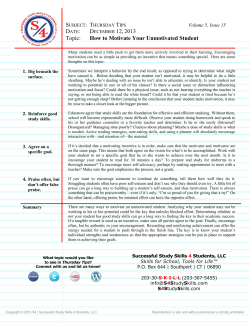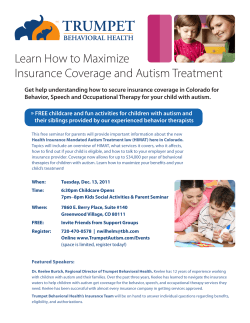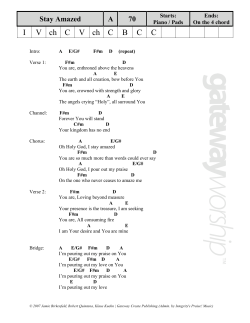
Social Skills
Social Skills Social skills are the skills we need to get along with other people. This may include parents, siblings, extended family, friends, teachers, other people in the community (eg shops, sports coaches, bus drivers and doctors). These skills are like a set of unwritten rules that we all follow to help us make and maintain relationships. We need social skills to help us to develop connections with others, to get our message across, to make friends and to understand what is going on around us. We begin to learn social skills from a very early age. You may not have given much thought to all the social skills that you use each day; like taking turns, smiling, laughing at someone’s joke, or saying please and thank you. Some children learn these skills easily but children with disability may find it more difficult. Your child may have difficulty with some of the following skills: • Body posture (Do they stand too close?) • Vocal inflection and volume (Do they sound angry, or happy even if their words are saying something else? Do they talk in a monotone voice or too loudly?) • Taking turns (Do they only want to talk about what they like? Will they share?) • Using proper greetings and farewells (Do they interrupt, or walk away when they are bored?) • Listening (Do they sometimes seem to be ignoring you?) • Responding to other people’s non-verbal cues (eg pointing to items of interest) • Understanding that there are some topics of conversation you don’t talk to some people about • Using appropriate eye contact • Recognising and responding to the feelings of others • Recognising when a person is joking • Beginning and ending a conversation. How can parents support social skills development? Children with disability often need someone to teach them social skills. Some ideas that can be used to teach social skills are listed below. Page 1 of 4 Visual strategies Visual strategies are things we see (including objects, pictures, photos or written language) that are used to support social exchanges and communication. Visuals can help your child remember what they are expected to do, when to do it, and all the steps involved in a new skill. Structured teaching sessions Parents can teach their child by modelling a new skill. Your child can then role-play and practice. It also helps the child to see other people using the skill in everyday situations (for example, at the shopping centre). Practising in as many places with as many people as possible increases the chances of your child learning the new skill and being able to apply it in different situations consistently. Priming This involves giving your child a special reminder just before they are going to need the skill. For example, if you are teaching them how to say thank you to a shop assistant, then before you go to pay for the purchase you quietly say, “Remember, we are learning to say thank you today.” Video Videoing your child successfully performing a skill or interacting socially can be a valuable teaching tool. Watching and replaying the video gives your child a chance to better understand the sequence of events pictured, their own behaviour and the responses of others. The video can be paused to allow you and your child to talk about the situation and for you to praise your child for positive social interactions. Social Stories™* These are stories or social scripts about common social experiences. Their purpose is to teach the child what to expect or how to behave in a social situation. The story describes a situation or a skill, including what happens, and common responses of the people involved. An important feature of the Social Story™ is that the process is a collaborative one between the parent and child. Encouragement It is important to praise your child for appropriate use of social skills. Just trying to be social can be hard for some young people with disability. Focus on feedback of the positives and be specific (eg, “You looked right at me that time—well done!”) so the child knows exactly what they did right. Praise, praise, praise! Cognitive Behaviour Therapy (CBT) You can also talk to a therapist about other techniques that can be helpful in teaching social skills. ‘CBT’ helps the child understand their thoughts and feelings, and how these affect how they act. It can be used to help the child change their behaviour, feel less anxious and interact with other people more effectively. As your child learns new skills, you may also like to consider: • formalised social skills groups • a mentor or buddy system • support groups • after-school activities and community activities. Page 2 of 4 Conclusion It is impossible to teach or plan for every social situation that will occur in your child’s life. The aim of any social skills teaching approach is to teach flexible strategies that the young person is able to adapt to other situations. The young person needs to be taught to generalise the skills learnt and to become observant in situations where they have less practice so that they can continue to build on their understanding and skills. This will increase their success in social interactions and developing relationships, and in turn their sense of community and self-confidence. References Autism and Asperger’s Resources and Teacher Training Workshops: http://www.suelarkey.com/ [Sue Larkey - Autism Educator] Accessed 24 June 2013. “Building Social Relationships” by Scott Bellini (2006) Autism Asperger Publishing Co, Kansas The Complete Guide to Asperger’s Syndrome: http://www.tonyattwood.com.au/ [Tony Attwood - Autism Educator] Accessed 24 June 2013 The Gray Center for Social Learning and Understanding: http://thegraycenter.org/ [The Gray Center] Accessed 24 June 2013 “More than Words” by Fern Sussman (1999) Hanen, Ontario * Social Stories developed by Carol Gray Page 3 of 4 Copies of this publication are available from the Disability Information Service Tel: 1300 786 117 Email: disabilityinfo@dcsi.sa.gov.au Website: www.sa.gov.au/disability Version: June 2013 Licensed under Creative Commons http://creativecommons.org/licenses/by-nd/3.0 Attribute to: The Dept for Communities and Social Inclusion, Government of South Australia
© Copyright 2025





















